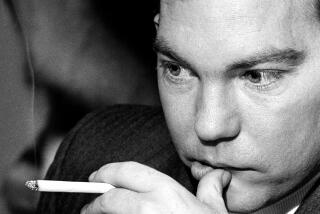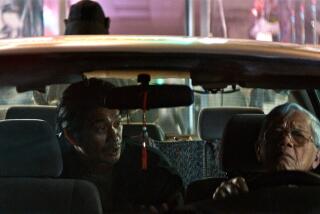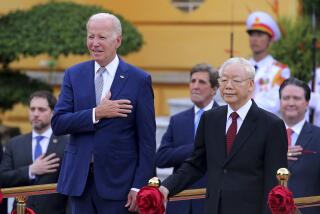Battleground Faces a Siege
- Share via
DIEN BIEN PHU, Vietnam — Here in remotest Vietnam, amid the ghosts of a defeated French army, Indochina’s most famous battlefield sits in a jungled mountain valley, largely forgotten by all but historians and a handful of Vietnamese visitors.
Although the town keeps waiting for tourists, few ever come, and the battlefield, as pristine as it is ignored, may not be able to hold out much longer against a threat that seems unusual in such a far-off place--urban encroachment.
Just as sprawling development has threatened many of Virginia’s historic Civil War sites, Dien Bien Phu--now a town of 55,000--is spreading out to the doorstep of the hilltop firebases where France suffered a stunning defeat in 1954 that changed the course of Southeast Asian history.
This was only a valley village of a few thousand mountain tribes people when France made its last stand to save its Indochinese empire. But last year, when the government chose Dien Bien Phu to replace Lai Chau as the provincial capital, construction projects and new inhabitants started transforming the town from a sleepy hamlet into something of a boomtown.
Streets are being torn up and widened. The French military airstrip became a commercial airport with four flights a week from Hanoi. The town packed up its generators and was connected to the national electrical system--the last provincial capital to be linked--and Le Thanh Than fixed up his 20-room hotel and put booklets on AIDS prevention in every room, waiting for an influx of tourists.
But for the most part, they never came, and Dien Bien Phu, located near the Laotian border, a tough two-day mountain drive west of Hanoi, remains a historic treasure that few tourists ever see. The town couldn’t even coax any visitors from the 3,000 delegates, journalists and staff members who recently converged on Hanoi for this year’s summit of French-speaking nations.
“We were expecting large numbers,” said Tran Tao Ding, 37, a guide at the military museum. What he didn’t realize was that France could no more celebrate the siege of Dien Bien Phu than the U.S. could the fall of Saigon. And so Eliane, Beatrice, Claudine and the other firebases that a French general named for his mistresses are largely ignored by all except small numbers of Vietnamese tourists.
While nothing remains of American battles in Khe Sanh, the Ia Drang Valley and Hamburger Hill, Dien Bien Phu, largely because of its isolation and prominent role in the Vietnamese psyche, is still a gold mine for history buffs and military strategists. It’s an Asian Gettysburg, a time freeze so well preserved that the sights of battle are easily replayed in the mind’s eye.
Rusting tanks and howitzers stand silent guard over fields of beans and sweet potatoes. France’s seven hilltop firebases seem to have been abandoned only yesterday. Chunks of shrapnel lie about, and in the command bunker of the late Brig. Gen. Christian de Castries, one can almost hear the echo of his last radio message May 7, 1954: “Au revoir. . . . Vive la France!”
“This has always been a childhood dream to come here,” said Anil Malhotra, a World Bank official from India who lives in Hanoi and appeared to be one of only two or three foreigners in Dien Bien Phu recently.
“The very first memory I have of talking foreign affairs with my father was when Dien Bien Phu fell. It was a source of great pride in the developing world. A small Asian nation had defeated a colonial power, convincingly. It changed history.”
*
France started building up its garrison in this valley in December 1953, hoping to draw Ho Chi Minh’s Communist guerrillas, known as the Viet Minh, into a conventional battle in which French planes and artillery could cripple the independence movement. But France ended up being caught in the very trap it tried to set.
Although the French considered their position impregnable, the Viet Minh managed to haul heavy artillery into the surrounding mountains and to dig tunnels and trenches to the doorstep of France’s perimeter. They closed down the airstrip with heavy bombardments, overran the firebases one by one and launched a final assault in human waves. The siege lasted 56 days.
“Our soldiers set off a charge under the French firebase we called A-1 over there,” said Le Kim Nhang, 60, a former Viet Minh guerrilla, pointing to a nearby hill. “That was our signal for the final attack. The fighting was very, very fierce.”
De Castries and the survivors of his garrison of 16,544 men--70% of whom were Legionnaires, North Africans and Vietnamese--surrendered to the 50,000-man Viet Minh force and were marched about 300 miles to POW camps beyond Hanoi. Many died en route. (Vietnam refused to grant De Castries a visa to return for the 30th anniversary of the surrender in 1984.)
The battle, which claimed as many as 25,000 lives, gave international prominence to the man who became North Vietnam’s master strategist, Gen. Vo Nguyen Giap, who, now in his mid-80s, lives quietly in Hanoi.
“We strictly followed this fundamental principle of revolutionary war: Strike to win, strike only when success is certain; if not, then don’t strike,” Giap later wrote.
Historians looking for the echoes of history would find plenty in Dien Bien Phu. It was here that a French general first spoke of seeing “a light at the end of the tunnel,” a phrase U.S. generals would repeat a generation later. It was here that the first Americans died in Vietnam combat--James McGovern Jr., 32, of Elizabeth, N.J., and Wallace Buford, 28, of Ogden, Utah, civilian pilots shot down in May 1954 trying to resupply the French garrison.
*
And it was here that the Eisenhower administration, although bankrolling France’s war, heeded the advice of two top World War II commanders, Gen. Matthew Ridgway and Lt. Gen. James Gavin, and, over the objections of Secretary of State John Foster Dulles, refused to become militarily involved. Its position was that the U.S. had no regional interests to justify involvement.
As a result of Dien Bien Phu’s fall, France’s Indochinese empire--Vietnam, Laos and Cambodia--collapsed. At a Geneva conference the following July, Vietnam was divided into two countries--a Communist North and a pro-West South--setting the stage for U.S. involvement in a second Indochina war.
“If you had studied our history, studied Dien Bien Phu, where our soldiers were willing to suffer any hardship against overwhelming firepower, you never would have done it,” said Le Van Cam, 67, who lost a leg fighting at Dien Bien Phu.
* PROTEST BY VIETNAMESE
5,000 call attention to homeland’s human rights abuses. A28
More to Read
Sign up for The Wild
We’ll help you find the best places to hike, bike and run, as well as the perfect silent spots for meditation and yoga.
You may occasionally receive promotional content from the Los Angeles Times.






